Tag: classics
Lovely black eyes
23 June 2015 | This 'n' that
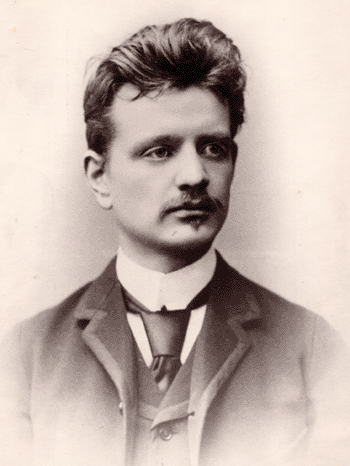
Agony uncle?: Jean Sibelius during his travels in Germany, in 1889
Jean Sibelius on how to keep your mojo
The main music critic of Päivälehti (‘The daily newspaper’) in the 1890s was the celebrated composer Oskar Merikanto, writes Vesa Sirén in Päivälehti’s successor, Helsingin Sanomat. Often, but not always, Merikanto praised first performances of works by the yet more stellar Jean Sibelius.
June 1895, however, saw the publication of Merikanto’s I sommarkväll (‘Waltz for a summer’s night’). ‘Tomorrow’s Päivälehti should have a review by Sibelius!’ wrote an excited Merikanto.
The short review duly appeared the following day, attributed not directly to Sibelius but to ‘a certain prominent composer’. In it, Sibelius hints that its uses may be more than strictly musical:
This waltz is extraordinarily pleasant and clever in both form and content. The introduction immediately reveals the composer’s intentions. This waltz contains an extraordinary passion. It is like our sky, which seems so grey, but which reflects that grey light that is born in black eyes when one is with one’s beloved. Everyone should buy it, for it is the shortest route to acceptance by one’s beloved and to one’s true desires.
New from the archive
11 June 2015 | This 'n' that
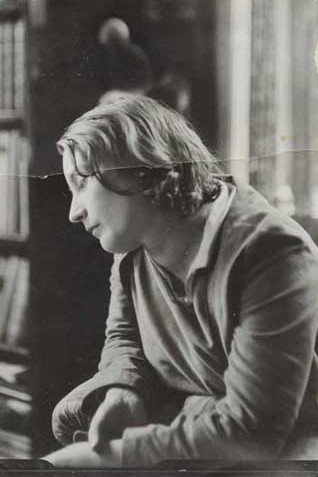
Helvi Hämäläinen. Photo: Literary Archives of the Finnish Literature Society.
This week, an excerpt from Helvi Hämäläinen’s gorgeously sensuous novel Säädyllinen murhenäytelmä (‘A respectable tragedy’,1941)
Right at the top of the list of untranslated Finnish masterpieces, for me, is Helvi Hämäläinen’s monumental Säädyllinen murhenäytelmä.
Written in the fateful summer of 1939, as the world waited for war, this story of love among the Helsinki intelligentsia is at the same time both a roman a clef – it caused a sensation on publication as the real people behind the fictional characters were recognised – and a vivid picture of its age. The falling cadences of its luxuriantly proliferating phrases offer a voluptuously aesthetic poetry of the senses as they slowly tell the story of love lost and then, gradually, regained. And the book answers the question, what was it like to be alive then?, with incomparable vividness. In this extract, the novelty of apartment living in the 1930s, the colours and smells, the new social habits, are all brought to life with extraordinary intensity.
We also republish a selection of poems published much later in Hämäläinen’s life, many of them impassioned elegies for the lives lost in the Second World War, giving voice to the sheer weight of sorrow, of grief for those who were lost.
If you’d like to read more, Soila Lehtonen’s evocative essay on Säädyllinen murhenäytelmä accompanies another excerpt; while a glimpse of its sequel, Kadotettu puutarha, (‘The lost garden’, 1995), follows the story onward to an elegiac description of the parts of Karelia that were ceded to the Soviet Union in the Second World War.
![]()
The Books from Finland digitisation project continues, with a total of 396 articles and book excerpts made available on our website so far. Each week, we bring a newly digitised text to your attention.
New from the archive
8 June 2015 | This 'n' that
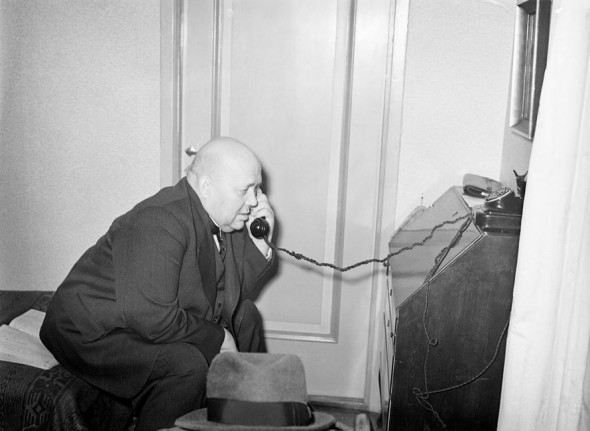
F.E. Sillanpää in his home receives the news that he has been awarded with the Nobel prize in literature in 1939.
This week, a short story from Finland’s one and only Nobel laureate, F.E. Sillanpää
Time has largely forgotten Frans Emil Sillanpää (1888-1964), but in the interwar years of the last century this complex writer – biologist, realist, mystic and proponent of ‘life-worship’ – was one of the most prominent in Finland. His work, intriguingly archaic and modern at the same time, is well represented by Järvi (‘The lake’, 1915), the short story we publish here.
Finland’s only Nobel Prize for Literature was awarded, perhaps not coincidentally, in the fateful year of 1939, and when Sillanpää travelled to Stockholm to receive his award, the Soviet Union had already attacked Finland. After the award ceremony, Sillanpää stayed in Sweden to raise funds for his beleaguered country.
![]()
The Books from Finland digitisation project continues, with a total of 393 articles and book extracts made available on our website so far. Each week, we bring a newly digitised text to your attention.
New from the archives
5 May 2015 | This 'n' that
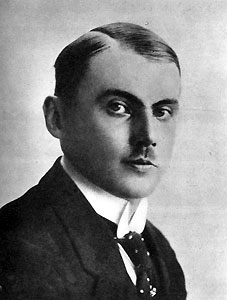
Runar Schildt
It’s a period that seems sometimes to have disappeared from view – Helsinki in the final years of Russian rule – but Runar Schildt’s short story brings it vividly to life. The characters – Sahlberg the baker and his mortal enemy, Johansson from the customs service; the restaurant-owner Durdin and Elsa, daughter of a commissionaire at the Senate, around whom the story revolves – spend a lazy but sexually charged summer Sunday in their villas just outside Helsinki, their hidden emotions all too familiar to those of a later age…
As the story’s translator, the formidably erudite George C. Schoolfield, remarks in his introduction, Runar Schildt (1888-1925) has often been hailed as a Finland-Swedish classic. There’s a quality of aesthetic decadence in his work that makes him very much a product of his time. There’s nothing, in Raketen, with its solid, belle epoque atmosphere, to foreshadow the change that was so soon to engulf Finland, with the granting of independence in 1917 and the bitter civil war that followed. Schildt was in Helsinki during the months when it was ruled by the Red side in the civil war; afterwards, he served as a clerk in the terrible detention camp for Red prisoners of war on Suomenlinna island. It was a new world, in which all the old certainties were questioned. Timid, conservative and something of a dandy (his friend Hans Ruin said he always looked as if he had stepped out of a bandbox), Schildt may well have felt out of tune with the times. By 1920 he had ceased to write the prose at which he excelled, and had turned to drama, with which he had much less success.
Schildt shot himself, in 1925, in the courtyard of the old university clinic in Helsinki. He was not yet 40.
New from the archive
26 March 2015 | This 'n' that
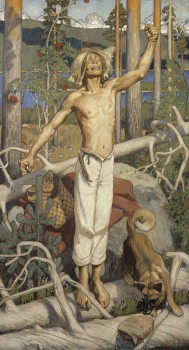
Kullervo’s curse. Painting by Akseli Gallen-Kallela (1899)
Finland’s national epic adapted for the stage by Finland’s national writer: best known as the author of the first significant novel in Finnish, Seitsemän veljestä (Seven Brothers, 1870), Aleksis Kivi (1834-1972) also turned one of the Kalevala’s grimmest stories, that of Kullervo – a tale of incest, revenge and death– into a five-act tragedy.
The translation is by one of Books from Finland’s most long-standing collaborators, David Barrett (1914-1998), a true linguistic genius with a speciality in Georgian as well as Finnish in addition to classical Greek; as well as his work with texts in Finnish and Georgian, he made extensive translations of Aristophanes for Penguin Classics. Barrett felt, as he argues here in his introduction, ‘that Kullervo, if suitably translated, might succeed where Seven Brothers had failed, in bringing Kivi’s genius to the notice of the English-speaking world’.
Was he right? It is up to you, dear readers, to judge.
For a very different, demythologized, view of the Kullervo story, we also publish a manuscript by the modernist poet Paavo Haavikko (1931-2008) from his television adaptation Rauta-aika (‘Age of iron’, 1982).
The Kalevala is in development as a film by the Finnish entertainment company Rovio, of Angry Birds game, and the Finnish-born video game company Supercell. It remains to be seen how the Kalevala take to the big screen.
*
The digitisation of Books from Finland continues, with a total of 372 articles and book extracts made available online so far. Each week, we bring a newly digitised text to your attention.
New from the archive
26 March 2015 | This 'n' that
This week’s pick is a comic short story by Martti Joenpolvi about the gender divide

Martti Joenpolvi.
Photo: Janne Aaltonen.
We first published this short story by Martti Joenpolvi, an acknowledged master of the genre, in 1989; it comes from the collection Pronssikausi (‘The bronze age’, 1988), which was nominated for the Finlandia Prize.
The subject – the story is about a man taking his mistress on a secret visit to his summer-house – provides plenty of opportunity for sly humour. But it’s a more unsettling read in 2015 than we’re guessing it was twenty-five years ago – not so much for the plot itself, which makes ironic fun of the idea of woman-as-chattel, as for the characterisation, which subtly places the woman exactly where the story does.
Enjoy!
*
The digitisation of Books from Finland continues, with a total of 375 articles and book extracts made available online so far. Each week, we bring a newly digitised text to your attention.
Angry epic heroes?
20 November 2014 | This 'n' that
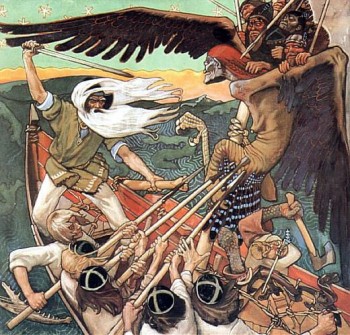
Action man: Väinämöinen fights the Hag of the North. Painting by Akseli Gallen-Kallela, 1896 (Turku Art Museum). Wikipedia
The Finnish national epic, the Kalevala, is the inspiration for a grand-scale film trilogy project. It involves employees of several entertainment media companies working on it in their free time. The Finnish entertainment media company Rovio that became famous for its Angry Birds game, and the Finnish-born video game company Supercell have sponsored – with other 13 media companies – the trailer: see IronDanger.
Financing is still in the planning stages, but it is hoped that the first part will be ready in 2017 when Finland celebrates its centenary year.
According to Rovio’s Chief Marketing Officer, Peter Vesterbacka, the film will be ‘adequately’ faithful to the original work. In an interview published on 19 November on the website of the Finnish Broadcasting Company YLE, he says that even if the landscape will look very Finnish, the intention is to ’tell the story to make it clear that it’s not about a bunch of old pensioners. These are young, heroic, epic heroes‘.
So, vaka vanha Väinämöinen – ‘Väinämöinen, old and steadfast’ – , the main character of the epic, the great shaman and the bard, the tragic hero, is to be kicked off the cast, because he’s, well, elderly?
Funny that the bearded wizard Gandalf of Lord of the Rings was not dismissed from the film due to his age, even though he does indeed looks as old as the hills of Gondor. (By the way, Väinämöinen has been ‘identified as a source for Gandalf’…)
It remains to be seen how the younger Kalevala crowd will deal with all that action. Who, for example, is going to sink the impetuous Joukahainen into a bog by singing, then?
Updated, alive
8 May 2014 | Non-fiction, Reviews
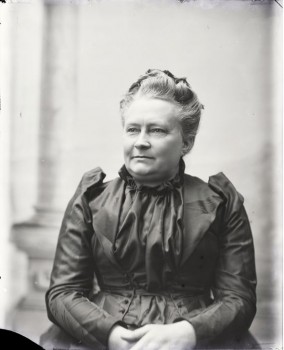
Minna at 50. The Finnish flag is flown on her birthday: 19 March has been named the Day of Equality. Canth also flies on the tail of one of the aircrafts of the Nordic airline Norwegian: the fleet carries portraits of ‘heroes’ and ‘heroines’ of four Nordic countries (the other Finn is the 19th-century poet J.L. Runeberg). Original photo: Viktor Barsokevich / Kuopio Museum of Cultural History
Herkkä, hellä, hehkuvainen – Minna Canth
[Sensitive, gentle, radiant – Minna Canth]
Helsinki: Otava, 2014. 429 pp., ill.
ISBN 978-951-1-23656-6
€40.20, hardback
There are two sure methods of preserving the freshness of the works of a classical author in a reading culture that is increasingly losing its vigour.
The first is to give a high profile to new interpretations of them, either in the form of scholarly lectures or of artistic re-workings, such as dramatisations, librettos or film scripts. Another unbeatable way to keep them alive as a subject of discussion is an updated biography, through which the author is seen with new eyes.
Minna Canth (1844–1897) is now celebrating her 170th anniversary, and she is fortunate in both respects. Having begun her literary career in the late nineteenth century, she still continues to be Finland’s most significant female writer.
Her influence on the role of women in society and, in particular, her promotion of girls’ education, is the cornerstone of Finland’s social equality. In the twenty-first century Canth’s plays are still receiving new interpretations, and they have also been made into operas and musicals. (Read her short story, ‘The nursemaid’, here.) More…
The nursemaid
Lapsenpiika (‘The nursemaid’), a short story, first published in the newspaper Keski-Suomi in December, 1887. Minna Canth and a new biography introduced by Mervi Kantokorpi
‘Emmi, hey, get up, don’t you hear the bell, the lady wants you! Emmi! Bless the girl, will nothing wake her? Emmi, Emmi!’
At last, Silja got her to show some signs of life. Emmi sat up, mumbled something, and rubbed her eyes. She still felt dreadfully sleepy.
‘What time is it?’
‘Getting on for five.’
Five? She had had three hours in bed. It had been half-past one before she finished the washing-up: there had been visitors that evening, as usual, and for two nights before that she had had to stay up because of the child; the lady had gone off to a wedding, and baby Lilli had refused to content herself with her sugar-dummy. Was it any wonder that Emmi wanted to sleep? More…
Kirjailijoiden Kalevala [The writer’s Kalevala]
7 February 2014 | Mini reviews, Reviews
 Kirjailijoiden Kalevala
Kirjailijoiden Kalevala
[The writer’s Kalevala]
Toim. [Ed. by]: Antti Tuuri, Ulla Piela ja Seppo Knuuttila
(Kalevalaseuran vuosikirja 92, the Kalevala Society’s yearbook 92)
Helsinki: Suomalaisen Kirjallisuuden Seura, 2013. 313 pp., ill.
ISBN 978-952-222-429-3
€47, hardback
The Kalevala is the Finnish national epic, compiled from oral folk poetry by Elias Lönnrot. It has provided a source of inspiration to Finnish culture since 1839. Kirjailijoiden Kalevala continues a project entitled ‘The artists’ Kalevala’, started in 2009. To start with, four scholars examine, from different viewpoints, the influence of folk poetry and the Kalevala on literature. Some twenty Finnish-language authors then approach the epic with original thoughts and literary means. The result may take the form of reminiscing, of a short story, poem or cartoon. In some texts the Kalevala is present only indirectly, in others some character of the epic is placed in the focus – Väinämöinen, Kullervo, Lemminkäinen or Aino. Kirjailijoiden Kalevala offers a multifaceted collection of viewpoints; aptly, the editors, in their foreword refer to the epic as a literary sampo, the mysterious, mythical object of the Kalevala that generates wealth and riches.
Verse and freedom
16 January 2014 | Articles, Non-fiction
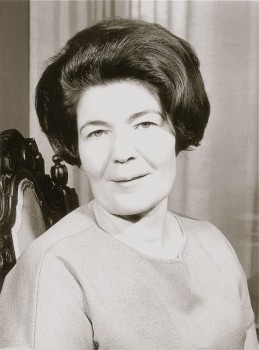
Aale Tynni (1913–1997). Photo: WSOY
Finnish poetic modernism, which with its freedom of rhythm came to dominate the literary mainstream of the 1950s, posed a particular challenge to the poets of the classical metrical and romantic poetic tradition. Aale Tynni (1913–1997) is not a poet of any one school or form, but rhythm is the deepest foundation of her poems, whether expressed in metre, free verse or the speech rhythms that characterise some of her poems of the 1950s and 60s, as well as those of her final years.
An Ingrian Finn, Tynni left Ingermanland near Petersburg for Finland as a refugee after the First World War, in 1919. The war and the period of uncertainty that followed it are present in her poems as an allegory, sometimes appearing as a dance of death or a carnival. At other times they emerge in the myth of Phaethon, who with his sun chariot is in danger of throwing Mother Earth off her axis, or as a game of chess in which God and the angel Gabriel play with the planets and moons as pieces. The poet makes use of mythic and cosmic references to widen her scope and to portray Man in the stages of history and the present age. More…
In good company
18 October 2013 | This 'n' that

Portrait of an artist: Joel Lehtonen, sketched by Pietro Annigoni in Florence, 1931. Picture: literary archives of the Finnish Literature Society
Margaret, Countess of Snowdon (Princess Margaret, 1930–2002), Joel, Master of Putkinotko (1881–1934), and Philip, Duke of Edinburgh (born 1921) met in the same museum case in Florerence in October, when an exhibition of the work of the artist Pietro Annigoni (1910–1988) was opened.
The morganatic juxtaposition of the English royals and the Finnish writer is based on Annigoni’s reputation as one of the best-known portraitists of the 20th century, in whom the royal courts of England and Denmark, among others, placed their trust.
Joel Lehtonen, author of the novel Putkinotko (‘Hogweed Hollow’, the name also refers to a place) and classic of Finnish literature, is included on account of the fact that, in celebrating his fiftieth birthday in Florence in 1931, he partied throughout the night with students from the Accademia di Belle Arte ‘to the rhythm of an excellent Chianti’.
Also present was the young Piero Annigoni, who, in a cellar restaurant, took out his working tools. A red-chalk portrait of Lehtonen was the result, along with a series of dancing girls drawn in Indian ink. ‘It was five in the morning before I realised,’ Lehtonen wrote back to Finland.
Lehtonen had already spent a year in Italy in 1908 translating Boccaccio’s The Decameron, which, to his annoyance, was censored by the publisher. He published a volume of poetic prose based on his Italian experiences, Myrtti ja alppiruusu (‘The myrtle and the rhododendron’), of which one section is dedicated to Florence, that ‘glittering, passionate city of the spirit’.
Young Florentine artists were used to world-class artists. When the poet Dylan Thomas visited the city in the 1940s, the poet and author Luigi Berti – an acquaintance of Lehtonen’s – complained that ‘poets travelling in Italy no longer give themselves the airs of “milords” – behave like Lord Byron.’ Lehtonen, however, was able to party stylishly and thoroughly in a way that appears to have pleased the sons of Florence.
As he set off on the return journey to Finland, Lehtonen wrote to his wife: ‘An embarrassing day is over’, ‘I am in fine spirits! Heat the sauna.’ He brought with him Annigoni’s works, which are now in the archive of the Finnish Literature Society.
The curator of the Florence exhibition found more sketches of Lehtonen in the Museo Annigoni: in the current show, they are placed alongside sketches of Princess Margaret and Prince Philip.
The opening of the exhibition, in the premises of the Ente Cassa di Risparmio di Firenze, was attended by 300 of the city’s elite. It was as if the nobility of the portraits of the Uffizi art gallery had stepped out of their frames to honour Annigoni, whose paintings continued the traditions of the renaissance. The Corriere della Sera and La Repubblica gave prominent coverage to the event. The young politician and Florence mayor Matteo Renzi said in his speech that in northern Italy Annigoni’s significance to art is parallel to that of Olivetti to industry.
Annigoni’s early portraits of Lehtonen are shown in a section entitled Opere rare o inedited. The 240-page catalogue also includes brief description of Lehtonen as a writer and an account of that night in Florence in 1931.
Translated by Hildi Hawkins
Aleksis Kivi: Kirjeet [Letters]
8 August 2013 | Mini reviews, Reviews
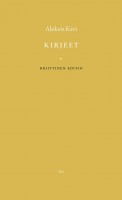 Kirjeet
Kirjeet
[Letters]
Critical edition, edited by Juhani Niemi et al.
Swedish-language letters translated into Finnish by Juhani Lindholm and Ossi Kokko
Helsinki: Suomalaisen Kirjallisuuden Seura (the Finnish Literature Society), 2012. 426 p, two map drawings
ISBN 978-952-222-390-6
€ 43, paperback
In his poetry, plays and masterly novel Seitsemän veljestä (Seven Brothers, 1870), Aleksis Kivi (1834–72) laid the foundations of Finnish fiction. Kivi died an early death, impoverished and mentally ill. In this critical edition seventy of his letters and three letters received by him are presented with notes and an introduction. Most of the book consists of background articles and supplementary items. Professor Jyrki Nummi provides an interesting analysis of biographies of Kivi. The other authors discuss, for example the literature Kivi drew on in his own works: he had read world classics in Swedish, but in Finnish there was not yet much to read apart from the folk poetry. Other topics of discussion are Kivi’s skill in using Swedish – the language of the educated class in Finland – and what his letters reveal about his network of acquaintances. The letters are grouped in chronological order, with introductions by Professor Emeritus Juhani Niemi. Most of the letters are comparatively short, sent to relatives and friends. They reflect Kivi’s attitude towards his own work, as well as his worries about his financial situation and declining health.
Translated by David McDuff
Books from Helsinki
30 June 2013 | This 'n' that

Helsinki: view it from different angles! Photo: Leena Lahti
Helsinki is relatively young city, Finnish literature even younger.
Flushed with a huge wave of migration at the beginning of the 20th century, the capital and its people went through the dramatic times of gaining independence and the Civil War (1917–18). The capital – since 1812 – and the life experiences of its inhabitants have been plentifully featured in Finnish fiction.
In his doctoral dissertation, Lieven Ameel has concentrated on a period of Finnish literary history. His Moved by the City: Experiences of Helsinki in Finnish Prose Fiction 1889–1941 (2013, Department of Finnish, Finno-Ugrian and Scandinavian Studies, University of Helsinki) examines more than sixty novels, collections of short stories and individual short stories portraying the city: how do the characters experience this urban public space? (Popular – crime fiction, for example – and children’s literature are excluded.) More…

